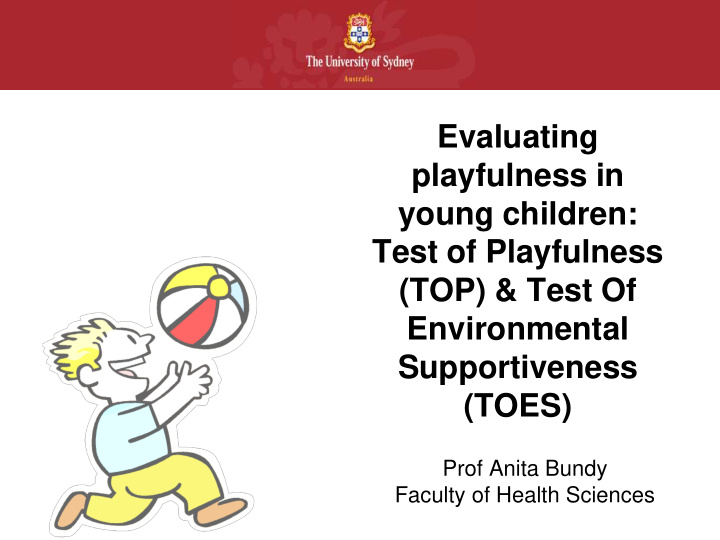



Evaluating playfulness in young children: Test of Playfulness (TOP) & Test Of Environmental Supportiveness (TOES) Prof Anita Bundy Faculty of Health Sciences
Play is a Paradox • Play is the primary Paradox: Statements occupation of that have children contradictory or • Play is the primary inconsistent means by which qualities. children learn • Play is a waste of time
What is play??? . With the person sitting next to you: • Define play in such a way that the definition separates play from all other activities • Fill in the blank: Play is . . .
Most play theorists agree. . . • No one has ever successfully defined play
One definition: Playfulness external internal control intrinsic extrinsic PLAY motivation not free free reality NOT PLAY
Assessments: Operational definitions • How would you know the elements if you saw them? – Intrinsic motivation – Internal control – Freedom from unnecessary constraints of reality – Framing • Introduction to the Test of Playfulness
Intrinsic motivation Engaged Plays for the process (not a reward) Persists Affect
Internal control Self Shared Decides Negotiates Safe Social play Modifies Supports Interacts with Enters objects Initiates Transitions Shares
Freedom from unnecessary constraints of reality Creative use of objects Mischief/teasing Pretends Clowns/Jokes
Framing • Gives clear play cues • Responds to cues of others • Maintains the play theme
Let’s Practice: Christopher • 2 ½ year old boy • Playing outdoors at day care
Is he playing? external internal control intrinsic extrinsic PLAY motivation not free free reality NOT PLAY
Intrinsic motivation Engaged Plays for the process (not a reward) Persists Affect
Internal control Self Shared Decides Negotiates Safe Social play Modifies Supports Interacts with Enters objects Initiates Transitions Shares
Freedom from unnecessary constraints of reality Creative use of objects Mischief/teasing Pretends Clowns/Jokes
Framing • Gives clear play cues • Responds to cues of others • Maintains the play theme
Environmental Support for Play: Introduction to the TOES • Step 1 : What is motivating the child? – What does the child get out of the activity?
TOES A. Toys • Step 2: How well do B. Playmates toys, playmates and • Giving cues play space help the • Reading cues child to meet his/her • Playing as equals motivations? C. Space • Amount & configuration • Safe • Accessible
TOES • Step 3: Is there anything you would like to change – to increase the environment-motivation fit?
Let’s Practice: Christopher • 2 ½ year old boy • Playing outdoors at day care
Environmental Support for Play • What is motivating the child? • How well do toys, playmates and play space help the child meet his/her motivations? • Is there anything you would like to change?
Other Aspects of Play
How would you assess these? • Skills children use in play – Transdisciplinary Play Based Assessment • Preferred play activities – Card Sort/Interest Profiles • Motivation for play – ???
Parting Thoughts • Play is the most important thing children do • Professionals often observe play to learn about children • Be sure you observe what you most want to observe: that which will teach you the most
Questions?
Let’s Practice • Kayden with playdough
Let’s Practice • Kayden 14 mos
Let’s Practice • Kayden feeding Fowler
Let’s Practice • Josh and Dad
Is he playing? external internal control intrinsic extrinsic PLAY motivation not free free reality NOT PLAY
Intrinsic Motivation Engaged Plays for the process (not a reward) Persists Affect
Internal control Self Shared Decides Negotiates Safe Social play Modifies Supports Interacts with Enters objects Initiates Transitions Shares
Freedom from unnecessary constraints of reality Creative use of objects Mischief/teasing Pretends Clowns/Jokes
Framing • Gives clear play cues • Responds to cues of others • Maintains the play theme
Recommend
More recommend